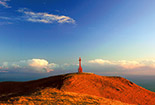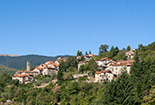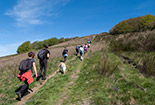Pontenano
in Casentino, a Tuscan valley with which you can get familiar in every detail through this site
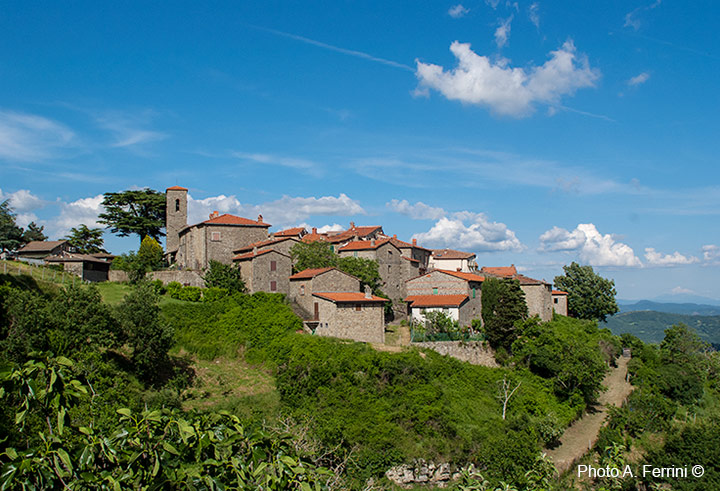
Texts and photos by Alessandro Ferrini ©
39 accurately described images of Pontenano and Pieve di Pontenano. Click to enlarge
Pontenano, a powerful castle in the Middle Ages
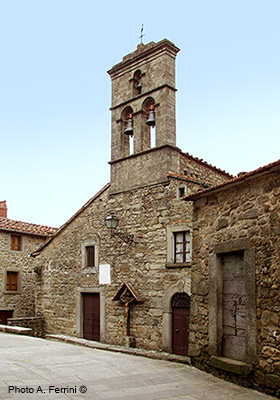 From Talla we can reach the village of Pontenano in just over seven kilometres.
From Talla we can reach the village of Pontenano in just over seven kilometres.
Before this place we meet the small village of Pieve di Pontenano. The name already says a lot about this village. Here there was the parish church of the Castle of Pontenano above. Almost nothing is known about the history of this church dedicated to the Conversion of St. Paul. Its origins can be dated between the end of the 13th century and the beginning of the 14th century and it was also used as a parish church for the Castle of Capraia. The building has been completely rebuilt and today it has a pleasant façade surmounted by a large bell tower. The church overlooks a small square from which an uphill road starts, along which most of the town develops. In the small square it is curious to notice on the walls of some houses the presence of pierced stones and an iron bell. They were used to tie animals such as donkeys and horses.
After about three kilometres you will reach Pontenano, at an altitude of almost 800 metres. No historical documentation talks about the origin of Pontenano, but it is thought that it was born on a 7th or 8th century barbaric settlement. This site, because of its dominant position on a vast territory, had a great strategic importance and this justifies the presence – since the 11th century - of a powerful castle controlled by the Arezzo bishops. This used to be such a strong ca- stle in Pratomagno that a document from 1385 – time in which this zone passed under the Florence rule – talks about the presence of 200 armed men in this place. Other historical sources testify a local production of weapons for the town of Arezzo, and this might suggest the presence in this zone of iron mines, a very important value at that time. Passed down the rule of Florence, in 1426 the Tuscan city was forced to destroy completely the castle because of the insubordination of its untamable inhabitants. Of that glorious past, Pontenano can show very little today, though there are still traces. Where the walls oriented toward Arezzo used to stand, today there is a door, though the most meaningful testimony is a great bell still used nowadays, on which you can see the inscription “IACOPUS ME FECIT MCCCLII”, an imperial eagle and a crossed shield – crest of the people of Arezzo.
The present church dates back to the 16th century. Inside there are two paintings worthy of mention: the first is a fresco from the same century showing St. Blaise and St. Lucy, the second is a canvas dated 1713 which depicts a Crucifixion between St. Margaret and St. Blaise to whom the church is dedicated.
Pontenano is the starting point of a historical and naturalistic walk that, in about five kilometers – the first three of which can be also traveled with an off-road vehicle – leads to the Santa Trinità in Alpe suggestive ruins – at 950 meters of height. This abbey was founded around 960 by two Teutonic monks by the will of Ottone I, the soon-to-be emperor who had the project of reorganizing a territory which was quite damaged politically and spiritually. The Santa Trinità abbey was a very important religious and cultural center and, from the beginning of the 11th century, many territories were given to the abbey, especially in Valdarno, and it had the jurisdiction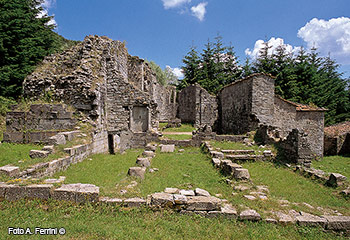 over many churches. From the middle of the 14th century, as the Florentine dominion enlarged, this abbey lost its political power. Therefore, in 1425, they asked to be aggregated to Vallombrosa, whose monks in the same year, or in the following one, commissioned to Mariotto di Cristofano – an artist from Valdarno – a polyptych destined for Santa Trinità with their two most important saints: Giovanni Gualberto and Bernardo degli Uberti. This was a sort of certificate of property. This important artwork is conserved today in the church of Carda. The walk from Pontenano to the Santa Trinità abbey passes though wonderful chestnut, beech and fir forests. Six-hundred meters before the abbey, there is the Specchiana moat. This watercourse, in the first one-hundred meters below the street, show a particular naturalistic aspect: an alga painted red the paved bottom of the moat.
over many churches. From the middle of the 14th century, as the Florentine dominion enlarged, this abbey lost its political power. Therefore, in 1425, they asked to be aggregated to Vallombrosa, whose monks in the same year, or in the following one, commissioned to Mariotto di Cristofano – an artist from Valdarno – a polyptych destined for Santa Trinità with their two most important saints: Giovanni Gualberto and Bernardo degli Uberti. This was a sort of certificate of property. This important artwork is conserved today in the church of Carda. The walk from Pontenano to the Santa Trinità abbey passes though wonderful chestnut, beech and fir forests. Six-hundred meters before the abbey, there is the Specchiana moat. This watercourse, in the first one-hundred meters below the street, show a particular naturalistic aspect: an alga painted red the paved bottom of the moat.
Another nice walk with departure from Pontenano is possible through the path CAI 48 that starts from the center of the village. The path, after having passed next to the ancient source of Pontenano, in about two kilometers leads us to a stream that is crossed by a small bridge of medieval origin perfectly preserved. A small architectural jewel. Continuing along the route, in about a kilometre we reach the Crocina Pass.



